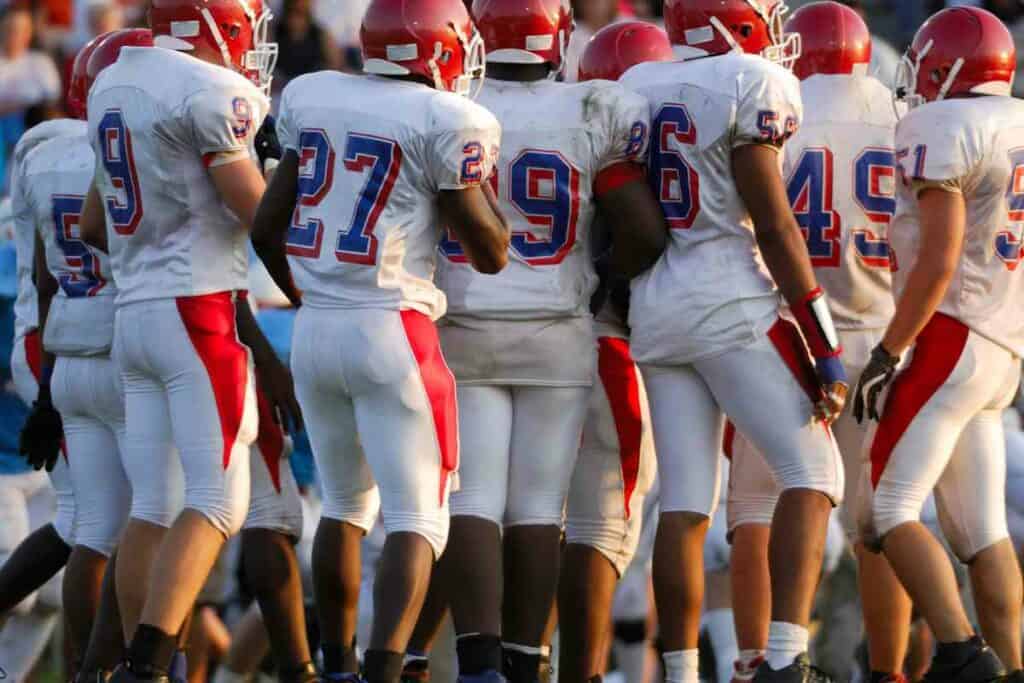How Many Timeouts in High School Football: Understanding the Rules

Have you ever wondered how crucial time management is in high school football? It’s often the unsung hero in those nail-biting matches. Just like in college and the NFL, timeouts play a big part, but there are some key differences you should know about – whether you’re a coach, player, or a fan cheering from the stands.
Related Post! How High School Football Overtime Works
How many time-outs do you get in high school football?
In high school football, each team is allotted three timeouts per half. These timeouts are crucial for strategic planning and clock management, but they don’t carry over to the next half or overtime. Coaches and players must use them wisely to influence the game’s flow and outcome.
Think of these as golden opportunities – whether it’s to strategize, stop the clock, or give your players a breather. But here’s a twist: unlike in college or the NFL, you can’t roll over unused timeouts to the next half or overtime. So, making smart decisions on when to use them is crucial for controlling the game’s pace and momentum.
Key Takeaways
- Three Timeouts Per Half: Each high school football team has this luxury.
- No Rollover: Unused timeouts don’t carry forward – use them or lose them.
- Strategic Advantage: Timely timeouts can sway the game’s rhythm and clock.
Related Post! How Long Do High School Football Games Last?
Diving Into Timeouts
Understanding the ins and outs of timeouts in high school football isn’t just about knowing the rules; it’s about mastering the art of game strategy and clock management.
Timeout Basics
A timeout is your team’s mini-pause button. Lasting about 1 minute, it stops the play clock, letting you huddle up for strategy talks, catch your breath, or deal with injuries. Remember, every team gets three per half, according to the National Federation of State High School Associations (NFHS).
Types and Uses
- Regular Timeouts: These are your strategic tools. Use them to tweak your game plan or halt the clock, especially towards the end of a quarter. It’s your team’s moment to regroup and refocus.
- Injury Timeouts: Safety first! If a player is hurt, the game pauses without eating into your three-per-half quota.
Stay alert to the officials’ signals and keep track of your timeouts. This awareness is key to coordinating your game strategies effectively.
High School vs College vs NFL: Know the Difference
In the diverse world of football, each level – from high school to the NFL – has its unique timeout rules, each influencing game strategy in different ways.
High School Timeout Rules
In high school, timeouts are straightforward. Three per half, one minute each, for strategic discussions, rest, or stopping the clock. There are no TV breaks here, keeping the game pace more consistent.
College Football Timeouts
In college games, under NCAA rules, you still get three timeouts per half. But, there’s an added twist: media timeouts. These longer breaks for TV ads can extend the overall game time.
NFL Timeout Regulations
The NFL steps it up with a more complex set of rules. You get three timeouts per half, lasting up to two minutes. And in overtime? Each team gets two additional timeouts. Plus, there are special ‘replay review’ stoppages in the final two minutes of each half and in overtime, which don’t count against your timeout tally. These can be game-changers, especially during crucial moments near a half’s end.
Managing the Game Clock and Timeouts
In high school football, mastering time management isn’t just a skill – it’s an essential strategy that can turn the tides of a game, especially during the high-stakes moments of the fourth quarter and overtime. Let’s delve into how managing the clock and timeouts can make or break a game.
Play Clock Precision
The 40-second play clock is like a ticking heartbeat in high school football. Once a play concludes, this countdown starts, nudging teams to kick off the next play before time runs out. Falling behind this clock results in a delay of game penalty – a setback no team wants. Coaches and players need a keen eye on this clock, especially when the pressure is on in the final quarter or overtime. Avoiding penalties here is crucial; they can be the difference between victory and defeat.
Timeout Tactics
Here’s where it gets strategic: Each team has three timeouts per half. These aren’t just breaks; they’re powerful tools for clock management. Using a timeout wisely can pause the clock, offering a moment to breathe, plan, or execute plays that need precision without the pressure of a ticking clock.
In the game’s final stretch, how you use these timeouts can shape the outcome. Teams often hold onto them for the last crucial two minutes, especially in a tight second half. They’re your chance to craft pivotal plays, tweak your defense, or disrupt the opposing team’s rhythm.

Gameplay Impact of Timeouts
Timeouts are the strategic heartbeat of high school football. They can shift the game’s momentum and open doors for tactical adjustments. Picture this: Your team’s offense is figuring out the opposing defense’s pattern. A timeout can provide that much-needed pause to strategize and exploit their weaknesses. On defense, a timeout could be the breather needed to prepare for a game-changing down.
The Psychology of Timeouts
Don’t underestimate the psychological impact of timeouts. They can dampen or amplify a team’s energy. Imagine your team has just made a big play like an interception. An opposing coach’s timeout can quench that burst of energy, giving their team time to regroup. Conversely, after a score or a successful play, regrouping can build up your team’s confidence, fueling them for the next challenge.
In essence, in high school football, time management is much more than just watching the clock. It’s about using every second, every timeout as a stepping stone towards victory. Whether it’s the play clock’s relentless countdown or the strategic use of timeouts, each element plays a critical role in shaping the game’s direction, momentum, and ultimately, its outcome. Remember, in the high-stakes environment of high school football, every tick of the clock matters!
